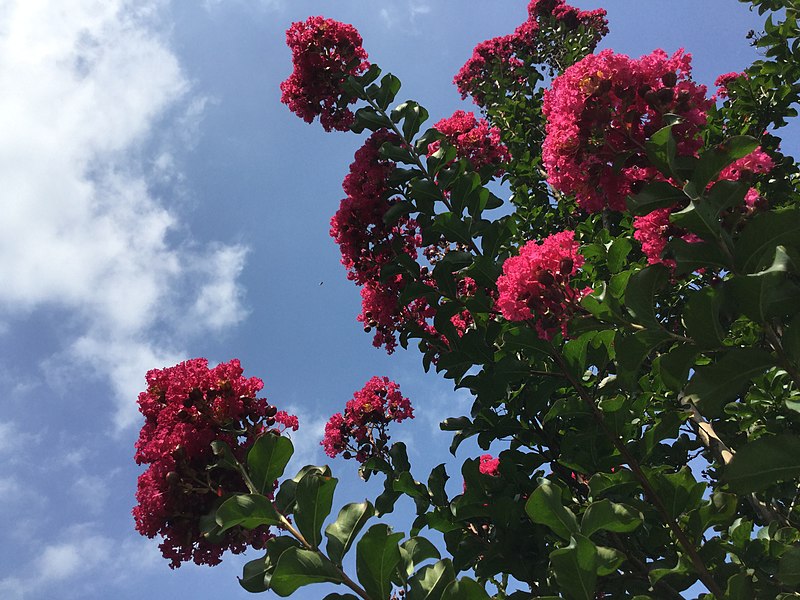Plant Information

Lagerstroemia or crape myrtle is a genus of about 50 species of deciduous and evergreen trees and shrubs in the family Lythraceae, that are native to the Indian subcontinent, southeast Asia, northern Australia and parts of Oceania, cultivated in warmer climates around the world. The most popular species, Lagerstroemia indica, arrived in England from its native China in 1759, and introduced into the United States in Charleston, South Carolina, between 1787 and 1796. It was quickly propagated and grown and has become a dominant landscape plant throughout the South. It is becoming an increasingly common shrub in the Mid-Atlantic states all the way up through the coastal areas of Massachusetts. It also thrives in the Mediterranean and desert climates of Southern California, Arizona and Nevada, and also in Australia as a street plant. Nowadays, many varieties are hybrids that maximize the colorful blooms of the common crape myrtle (Lagerstroemia indica) and/or the distinctive bark, cold hardiness, and disease-resistance of the Japanese crape myrtle (Lagerstroemia faurei).
Crape myrtles are very popular in home landscapes for their audacious spikes of pink, purple, white, or red flowers crowning its sculptural branches for months in summer. It is one of only a few trees/shrubs to offer brilliant color in late summer through autumn, at a time when many flowering plants have exhausted their blooms. In autumn, leaves turn a brilliant red or orange, and its peeling bark brings winter interest. They truly come in every possible size and shape, from knee-high shrubby dwarf plants to towering tree forms, so it is possible to choose a variety for any landscaping use. They typically grow in USDA Plant Hardiness Zones 5 to 10. Low maintenance needs make it a common municipal planting in parks, along sidewalks, highway medians and in parking lots.
Crape myrtles do very well in the home garden, as their care is nominal. They adapt to most any kind of soil, as long as it is well-drained. The ideal soil pH is neutral to slightly acidic. They do best in full sun – the sunnier the spot, the better, but they should get at least 6 hours of sun each day. Crape myrtles benefit from annual feeding with a general-purpose or high-nitrogen fertilizer, in early spring as soon as leaves come out. They are drought-tolerant and do not need to be watered under normal conditions. They bloom on this year’s new growth (sometimes called “new wood”), so pruning should be done during late winter before growth starts. Most growers and researchers agree that only light pruning is necessary for plenty of blooms.
Crape myrtle flowers attract hummingbirds, as well as insects that hummingbirds and other birds eat. Goldfinches, dark-eyed juncos, house finches, cardinals, and house and white-throated sparrows visit the trees continually from late autumn through winter to feed on the abundant seed crop that crape myrtles provide.
Economics
According to the USDA NASS Census of Horticulture, crape myrtles sold for a wholesale value of $69.6M in 2019.
 Main Disease Problems
Main Disease Problems
Crape myrtles have relatively few disease problems, with the powdery mildew (Erysiphe lagerstroemiae) the most prevalent one. Other common diseases include leaf spots (Cercospora spp., Phyllosticta spp.), and root rots (Armillaria sp., Ganoderma lucidum, Phymatotrichum omnivorum).
Main Pest Problems
Crape myrtles have a variety of pests, with the crape myrtle aphid, Tinocallis kahawaluokalani, the most common one; sooty mold often grows on the aphid honeydew secretions. Other common pests include crape myrtle bark scale (Eriococcus lagerstroemia), Japanese beetle (Popillia japonica), crape myrtle flea beetle (Altica litigata), Asian ambrosia beetle (Xylosandrus crassiusculus), brown striped beetle (Colaspis floridana), and an exotic weevil (Callirhopalus bipunctalus).
IR-4 Research
IR-4 has sponsored 98 crop safety trials with 37 products, and we have screened 18 new actives with crape myrtles for effective management of crape myrtle bark scale (Eriococcus lagerstroemia) and Japanese beetles (Popillia japonica).
Sources Cited
https://en.wikipedia.org/wiki/Lagerstroemia_indica
https://en.wikipedia.org/wiki/Lagerstroemia
https://www.southernliving.com/home-garden/gardens/southern-gardening-crepe-myrtle-history
https://garden.org/learn/articles/view/4220/
https://plants.usda.gov/plantguide/pdf/pg_lain.pdf
https://www.crapemyrtle.com/growing-the-perfect-crape-myrtles.html
https://hgic.clemson.edu/factsheet/crape-myrtle-diseases-insect-pests/
https://todayshomeowner.com/growing-crape-myrtles/
https://myperfectplants.com/grow-guides/crape-myrtle-grow-guide/
https://pcmg-texas.org/images/trees/crape_myrtle_pest.pdf
https://www.gardeningknowhow.com/ornamental/trees/crepe-myrtle/crepe-myrtle-pest-control.htm
https://www.thetreecenter.com/diseases-of-crape-myrtles/
https://ipm.ifas.ufl.edu/resources/extension_resources/newsletter/v1n1_myrtle.shtml
USDA-NASS Census of Horticulture, 2019.
Authors
Ely Vea, IR-4 Environmental Horticulture Program Assistant Manager and Jacqueline Cavaliere, IR-4 Environmental Horticulture Program Coordinator.


